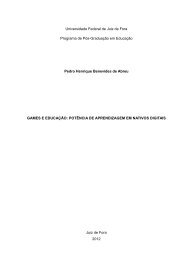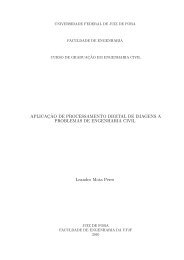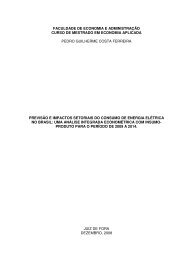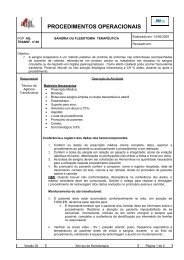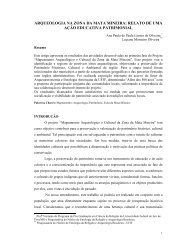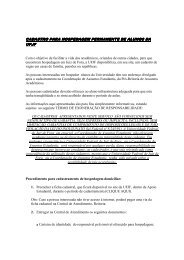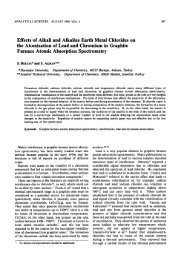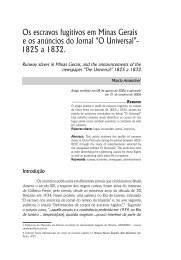Volume 6 | Número 2 Julho - Dezembro de 2012 - Universidade ...
Volume 6 | Número 2 Julho - Dezembro de 2012 - Universidade ...
Volume 6 | Número 2 Julho - Dezembro de 2012 - Universidade ...
You also want an ePaper? Increase the reach of your titles
YUMPU automatically turns print PDFs into web optimized ePapers that Google loves.
Psicologia em Pesquisa | UFJF | 6(02) | 139-150 | <strong>Julho</strong>-<strong>Dezembro</strong> <strong>de</strong> <strong>2012</strong><br />
Costa, A. J., Silva, J. B. L., Chagas, P. P., Krinzinger, H.,<br />
Lonneman, J., Willmes, K., Wood, G., & Haase, V. G.<br />
(2011). A hand full of numbers: a role for offloadingin<br />
arithmetics learning? Frontiers in Psychology, 2, 368.<br />
Davis, J. M., & Broitman, J. (2011). Nonverbal<br />
learning disabilities in children. Bridging the gap<br />
between science and practice. New York: Springer.<br />
De Smedt, B., Swillen, A., Devriendt, K., Fryns,<br />
J. P., Verschaffel, L., & Ghesquiere, P. (2007).<br />
Mathematical disabilities in children with velo-cardiofacial<br />
syndrome. Neuropsychologia, 45(5), 885-895.<br />
De Smedt, B., & Gilmore, C. K. (2011). Defective<br />
number module or impaired access? Numerical<br />
magnitu<strong>de</strong> processing in first gra<strong>de</strong>rs with<br />
mathematical difficulties. Journal of Experimental<br />
Child Psychology, 108(2), 278-292.<br />
Dehaene, S. (1992). Varieties of numerical abilities.<br />
Cognition, 44(1-2), 1-42.<br />
Dehaene, S., & Cohen, L. (1995). Towards an<br />
anatomical and functional mo<strong>de</strong>l of number<br />
processing. Mathematical Cognition, 1(1), 83-120.<br />
Dehaene, S., Piazza, M., Pinel, P., & Cohen, L. (2003).<br />
Three parietal circuits for number processing.<br />
Cognitive Neuropsychology, 20(3), 487-506.<br />
Dirks, E., Spyer, G., van Lieshout, E. C. D. M., &<br />
De Sonneville, L. (2008). Prevalence of combined<br />
reading and arithmetic disabilities. Journal of<br />
Learning Disabilities, 41(5), 460-473.<br />
Feigenson, L., Dehaene, S., & Spelke, E. (2004). Core<br />
systems of number. Trends in Cognitive Sciences,<br />
8(7), 307-314.<br />
Fel<strong>de</strong>r-Puig, R., Baumgartner, M., Topf, R., Gadner,<br />
H., & Formann, A. K. (2008). Health-related<br />
quality of life in Austrian elementary school<br />
children. Medical Care, 46(4), 432-439.<br />
Ferreira, F. O., Wood, G., Pinheiro-Chagas, P.,<br />
Lonnemann, J., Krinzinger, H., Willmes, K., &<br />
Haase, V. (<strong>2012</strong>). Explaining school mathematics<br />
performance from symbolic and nonsymbolic<br />
magnitu<strong>de</strong> processing: similarities and differences<br />
between typical and low-achieving children.<br />
Psychology & Neuroscience, 5(1) 37-46.<br />
Fuchs, L. S., Geary, D. C., Compton, D. L., Fuchs,<br />
D., Hamlett, C. L., & Bryant, J. D. (2010). The<br />
contributions of numerosity and domain-general<br />
abilities to school readiness. Child Development,<br />
81(5), 1520-1533.<br />
Geary, D. C. (1993). Mathematical disabilities:<br />
cognitive, neuropsychological, and genetic<br />
components. Psychological Bulletin, 114(2), 345-62.<br />
Geary, D. C. (2005). Role of cognitive theory in the<br />
study of learning disability in mathematics. Journal<br />
of Learning Disabilities, 38(4), 305-307.<br />
Geary, D. C., Bailey, D. H., & Hoard, M. K.<br />
(2009). Predicting mathematical achievement and<br />
mathematical learning disability with a simple<br />
screening tool: The Number Sets Test. Journal of<br />
Psychoeducational Assessment, 27(3), 265-279.<br />
Granà, A., Hofer, R., & Semenza, C. (2006).<br />
Acalculia from a right hemisphere lesion <strong>de</strong>aling<br />
with “where” in multiplication procedures.<br />
Neuropsychologia, 44(14), 2972-2986.<br />
Gross-Tsur, V., Manor, O., & Shalev, R. S. (1996).<br />
Developmental dyscalculia: prevalence and<br />
<strong>de</strong>mographic features. Developmental Medicine<br />
and Child Neurology, 38(1), 25-33.<br />
Haase, V. G., Wood, G., & Willmes, K. (2010).<br />
Matemática. In L. F. Malloy-Diniz, D. Fuentes,<br />
P. Mattos & N. Abreu. (Eds.), Avaliação<br />
neuropsicológica, (pp. 123-132), Porto Alegre:<br />
ARTMED.<br />
Haase, V. G., Moura, R. J., Pinheiro-Chagas, P.,<br />
& Wood, G. (2011). Discalculia e dislexia:<br />
semelhança epi<strong>de</strong>miológica e diversida<strong>de</strong> <strong>de</strong><br />
mecanismos neurocognitivos. In L. M. Alves, R.<br />
Mousinho & S. A. Capellini (Eds.), Dislexia: novos<br />
temas, novas perspectivas, (pp. 257-282), Rio <strong>de</strong><br />
Janeiro: Wak.<br />
Halberda, J., Mazzocco, M. M. M., & Feigenson,<br />
L. (2008). Individual differences in non-verbal<br />
number acuity correlate with maths achievement.<br />
Nature, 455(7213), 665-668.<br />
Hartje, W. (1987). The effect of spatial disor<strong>de</strong>rs<br />
on arithmetical skills. In G. Deloche & X. Seron<br />
(Eds.), Mathematical disabilities, (pp. 121-125),<br />
Hillsdale, NJ: Erlbaum.<br />
Hecht, S. A., Torgesen, J. K., Wagner, R. K., & Rashotte,<br />
C. A. (2001). The relations between phonological<br />
processing abilities and emerging individual<br />
differences in mathematical computation skills: a<br />
longitudinal study from second to fifth gra<strong>de</strong>s. Journal<br />
of Experimental Child Psychology, 79(2), 192-227.<br />
Izard, V., & Dehaene, S. (2008). Calibrating the mental<br />
number line. Cognition, 106(3), 1221-1247.<br />
Jordan, N. C. (2007). Do words count? Connections<br />
between mathematics and reading difficulties. In<br />
D. B. Berch & M. M. M. Mazzocco (Eds.), Why is<br />
math so hard for some children? The nature and origins<br />
of mathematical learning difficulties and disabilities,<br />
(pp. 107-120), Baltimore, MA: Brookes.<br />
Heterogeneida<strong>de</strong> nas Dificulda<strong>de</strong>s <strong>de</strong> Aprendizagem da Matemática 148



